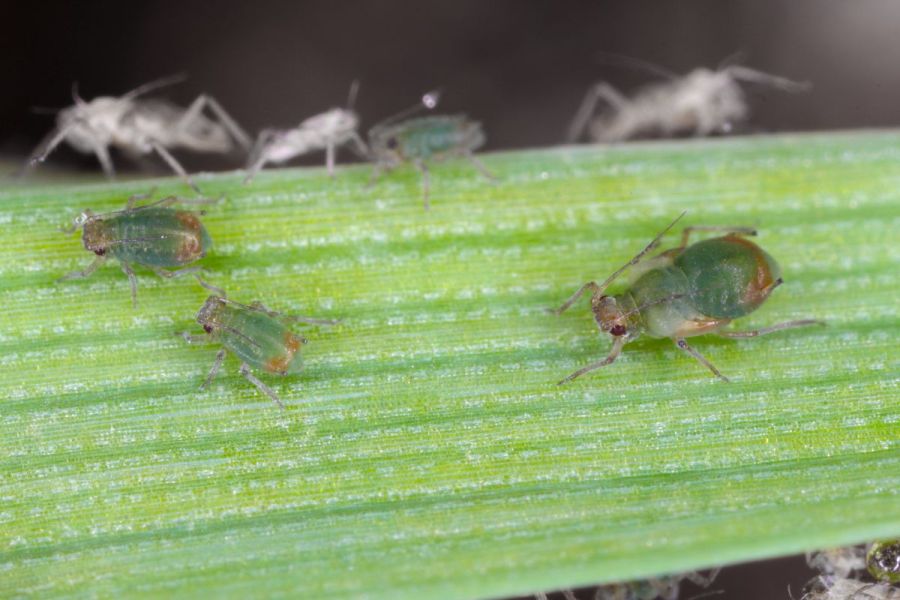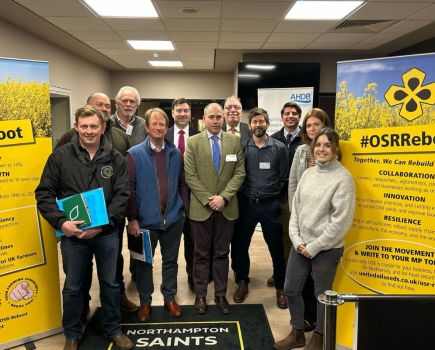As growers strive to reduce insecticide use spurred on by the incentives offered by SFI, what happens when high aphid pressure means there’s little choice but to consider a solution from a can? CPM talks pyrethroids.
“BYDV hasn’t gone away – levels have remained stable for the past two years with around 20% of aphids tested being infected.”
By Janine Adamson
With poor autumn weather conditions last year meaning many were unable to travel and spray crops, growers in the North West observed some of the worst barley yellow dwarf virus (BYDV) symptoms for decades. That’s according to Peter Clare, managing director of agronomy company Environmental Crop Management (ECM).
And despite advancements in plant breeding resulting in BYDV-resistant wheat varieties, he says if growers in his area (Cheshire and Lancashire) didn’t use autumn insecticides, subsequent wheat and barley yields would be down 20-30% if infected with the virus.
“In the North West, conditions can be very mild coupled with large hectarages of grassland plus a lot of trees and hedges. Because one way in which BYDV is vectored is by winged aphids which have been infected with virus from grass – and which require habitats to overwinter – this makes for a high risk scenario.
“Growers in other parts of the country may be able to get away with reducing their insecticide applications, maybe even eradicate use altogether, but for those who can’t, left untreated, aphid-vectored BYDV can result in complete crop losses in extreme cases,” he stresses.
In fact, Peter believes growing cereal crops without insecticides in the North West isn’t feasible at the moment. “You can’t afford the damage which results from infection; it plugs the plant up preventing sugars from moving around to sustain growth. It’s also not possible to delay drilling before the rain closes in for the season, which is a key cultural control technique.
“The only option is an integrated approach of other cultural methods – of which destroying the green bridge is most critical – alongside considered pyrethroid use,” he continues.
In terms of the green bridge, Peter notes volunteer cereals and infected grassweeds pose additional threats. That’s because BYDV is also spread directly by wingless aphids which survive on this material post cultivations.
“Start by destroying the green bridge from last year’s stubble using glyphosate. Then once drilled, growers and agronomists have to regularly field walk with an application of an insecticide as soon as a crop is at 2-3 leaves if aphids are present,” he adds. “It’s important to note that resistant ryegrass must also be controlled effectively or it’s prime for hosting the virus.”
Pyrethroids are the go-to synthetic option for aphid control, but concerns have been raised regarding their impact on beneficial insect populations as well as potential resistance issues. Rothamsted Research’s Dr Steve Foster says it all depends on which species of aphid is the vector as to whether resistance could be a problem.
“We have some concerns regarding the development of moderate pyrethroid resistance in Sitobion avenae (grain aphid). This species carries a gene mutation known as ‘knock-down resistance’, or kdr, which means pyrethroids don’t bind to it as well and are therefore less effective.
“In the thousands of aphids that have been screened during the years, there’s been no evidence of strong pyrethroid resistance above and beyond that yet, which means when applied at the correct and full rate with good aphid contact, pyrethroids should still provide control,” he explains.
Despite this positive message, recent samples from Norfolk could suggest otherwise. “Tested in lab-based bioassays applying a pyrethroid, these had the highest resistance ratio versus a fully susceptible sample – more than double what’s been seen before. Although unusual, it would suggest something is happening with that species which requires further clarification,” explains Steve.
However for principle BYDV vector Rhopalosiphum padi (bird cherry-oat aphid), there’s yet to be any reports of resistance or control failures which is good news for pyrethroid use, he adds. “Even so, BYDV hasn’t gone away – levels have remained stable for the past two years with just under 20% of all Rhopalosiphum padi samples tested being infected.”
But what about the risk to beneficial insects and invertebrates? According to Peter, one pyrethroid in particular poses less of a threat. “Being focused on environmental best practice, ECM instigated a study with Manchester Metropolitan University to understand the impact of esfenvalerate (as in Sven and Sumi-Alpha) on web-spinning spiders – the main predator of aphids.
“The results suggest that although the insecticide is initially disruptive to spiders, after a few days it’s back to business as usual. This is important given the role these beneficials play in integrated pest management,” he says.
Although the reason behind this outcome isn’t currently clear, what makes esfenvalerate different to other pyrethroids such as cypermethrin, is it has a different core make-up. Sumitomo Chemical’s Simon Leak explains with a different structure comes different properties. “Unlike most pyrethroids which have a pyrethrum core, esfenvalerate has a unique radical phenyl-acetate at its heart.
“This offers higher repellency and better stability which are useful properties in an insecticide. At the end of the day it’s a pyrethroid, but relatively speaking it’s definitely less aggressive and poses a lower toxic risk to bees.”
Work conducted by Rothamsted Research confirms this hypothesis, demonstrated using the Stevenson coefficient as a means of quantifying toxicity levels to bumblebees in field conditions. The calculation is based on LD50 (lethal dose) and field use rate (gai/ha) – the higher the coefficient, the more toxic the compound is (see table).
| Active ingredient | Dose g/ha |
LD50 μg / bee |
Stevenson coefficient | |
| Pirimicarb | 125 | 54 | 2.31 | |
| Esfenvalerate | 7.5 | 0.21 | 35.7 | |
| Deltamethrin | 6.25 | 0.051 | 122.5 | |
| Lambda-cyalothrin | 6.25 | 0.027 | 231.5 | |
| Cypermethrin | 25 | 0.056 | 446.4 |
Simon believes this data, coupled with greater awareness of how to target spray applications, means growers can make more informed choices. “Blanket spraying and adding insecticides to tank mixes just in case are becoming less commonplace on the whole. The impact of all synthetic plant protection products on the environment is far better understood.
“At the same time, varieties with resistance traits aren’t a silver bullet and require the back-up of chemistry – the two work hand-in-hand. This means we have to carefully manage the use of pyrethroids such as esfenvalerate to avoid resistance building up, or losing the active through revocation,” he says.
The latter point being important because at the moment, esfenvalerate is undergoing renewal by the Chemicals Regulation Division (CRD) with an outcome expected within the next 12 months. Even so, Simon says Sumitomo – the only manufacturer of the active ingredient – is confident the product will remain.
“As with other pyrethroids, esfenvalerate has been around for quite a long time so it’s an important product both globally and for the UK. It’s a quality product and it continues to deliver,” he adds.
To back this statement, applied in optimum conditions, esfenvalerate has the potential to last longer due to its persistency – something which Peter also commends. “We’ve had many years of success with Sven – it’s a low dose, very rainfast and persistent pyrethroid. If there’s a spray miss in a field, it’s completely obvious where the virus has taken hold. Equally, it’s rainfastness is an important quality when the weather can be as catchy as it is,” he concludes.
This article was taken from the latest issue of CPM. Read the article in full here.
For more articles like this, subscribe here.
Sign up for Crop Production Magazine’s FREE e-newsletter here.




